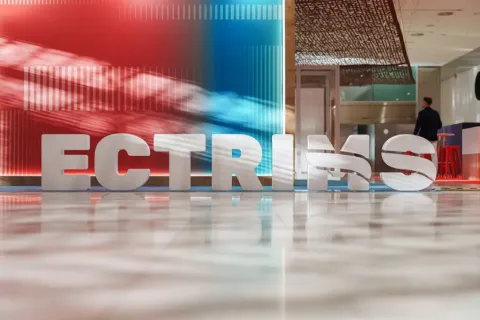Making Connections to Drive Progress in MS
Research Highlights from the 2025 ACTRIMS Scientific Conference

Every year, the Americas Committee for Treatment and Research in Multiple Sclerosis or ACTRIMS, hosts a scientific conference to share innovative discoveries that advance our understanding of research and clinical care for people living with MS. This year’s meeting focused on “making connections” across different fields of study by uniting researchers to drive progress in the science and treatment of MS and related disorders. The meeting brought together over 1,800 researchers, trainees, healthcare professionals, and others from around the world.
Here’s some emerging research from ACTRIMS, including discoveries in biomarkers, insights into EBV and MS, advances in imaging, and much more!
Kenneth P. Johnson Memorial Lecture

Dr. Jack Antel (McGill University) delivered the Kenneth P. Johnson lecture in recognition of his accomplishments and contributions to MS.
Dr. Antel reflected on how past discoveries have shaped our understanding of MS and how we manage the disease. He also pointed out several areas of research that could further improve MS care, like understanding what triggers the disease and why certain populations are more susceptible to MS, finding ways to enhance repair and remyelination through cells like microglia and oligodendrocytes, and changing the brain’s environment to prevent tissue damage. Ongoing research in these areas could uncover new and more effective approaches to treat MS. Learn more about this research.
2025 Barancik Prize for Innovation in MS Research

Dr. Mikael Simons (Technical University Munich) was awarded the prestigious Barancik Prize for Innovation in MS Research for his groundbreaking work on myelin biology and neuroinflammation (inflammation of the brain or spinal cord).
Dr. Simons was the first to uncover the biological processes of how myelin is created and wrapped around nerve fibres, setting the stage for research into myelin repair and how this process can fail in MS or with aging. His work also revealed how immune cells in the brain are driving inflammation and preventing repair of damaged myelin. Dr. Simons and team are now testing an FDA-approved drug for its ability to reduce myelin damage in MS, offering hope for better treatments to promote myelin repair and restoration.
Discoveries in MS Biomarkers
Dr. Jiwon Oh (University of Toronto) shared new findings from the phase 3 clinical trials on the Bruton’s Tyrosine Kinase (BTK) inhibitor, tolebrutinib. The main trial results showed tolebrutinib slowed disability progression in people with relapsing MS and non-relapsing secondary progressive MS. In this sub-study, the researchers found that tolebrutinib may have a greater impact in slowing disability worsening in participants whose imaging scans showed paramagnetic rim lesions or PRLs at the beginning of the trial. PRLs are a type of chronic active lesions linked to inflammation, demyelination, and disability progression in people with MS. These findings also show that PRLs can potentially be used as an imaging biomarker to predict disability worsening in people with MS and a way to assess treatment response. Learn more about this research.
Dr. Erin Beck (Mount Sinai) talked about a new technology for predicting brain age (how old someone’s brain looks based on biology and function) compared to chronological age (how old a person is) using brain imaging scans. Dr. Beck showed that the brain ages about 4 years faster in people with MS compared to their chronological age, suggesting that brain age may be used as a promising biomarker for tracking disease progression. Learn more about this research.
Yuan Ding (McGill University) presented a new set of blood-based biomarkers with the potential to detect preclinical MS years up to 15 years before diagnosis and the degree of disease severity. These biomarkers present an opportunity for earlier intervention and prevention, but they need to be supported by more scientific evidence before being used in the clinic. Learn more about this research.

EBV and MS
Dr. Dalia Rotstein (University of Toronto) presented findings from an MS Canada-funded study linking the MS prodrome to symptomatic Epstein-Barr virus (EBV) infection, known as infectious mononucleosis or ‘mono’. Using population health data from Ontario, Canada, the researchers reported that the average time from mono to MS onset was about 11.5 years. Those who went on to develop MS showed increased levels of healthcare service use from the time of contracting mono and onwards, suggesting that the MS prodrome may begin as early as the time of mono. These findings further support the role of EBV as an early trigger for MS onset. Learn more about this research.
Dr. Devin King (Brigham and Women’s Hospital and Harvard Medical School) shared results from a study suggesting that reactivation of EBV in infected B cells may be involved in MS relapses. Dr. King and team found that the immune cells of a small group of people with relapsing-remitting MS (RRMS) undergo significant changes in their genes before a relapse, and that these genetic changes are linked to the body’s response to EBV reactivation. These results provide more evidence of the contribution of EBV in the MS disease process. Learn more about this research.

Advances in Imaging
Drs. Sara Collorone (University College London) and Dan Milea (Singapore Eye Research Institute) shared exciting advancements in the use of eye imaging tools for diagnosing and predicting MS and related disorders. For example, optic coherence topography or OCT is a non-invasive tool that captures images of the retina (back of the eye) and can detect optic neuritis, a common symptom of MS. Combining OCT with advanced artificial intelligence and machine learning technology has also allowed MS to be distinguished from other neurological conditions like neuromyelitis optica spectrum disorder (NMOSD) and MOG antibody disease (MOGAD).
Another revolutionary development in eye imaging is the ability to capture images of the eye at the cellular level, revealing nerve fibres, nerve cells and immune cells to provide valuable insights into mechanisms of neurological damage. This new era of imaging has the potential to improve diagnosis and prognosis of MS.
Additional resources:
Our overview only captures a few of the latest breakthroughs in MS research presented at ACTRIMS 2025. For more information, you can access the ACTRIMS abstract catalog.
- Log in to post comments

